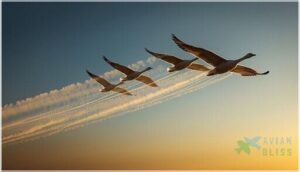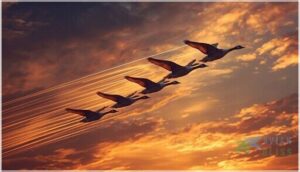This site is supported by our readers. We may earn a commission, at no cost to you, if you purchase through links.

You’ve seen it—a flock of birds slicing across the sky in perfect symmetry, wings beating in a crisp V. What looks like a casual parade is anything but accidental.
Nature, ever the engineer, has wired these travelers for teamwork. Turns out, flying in a V formation doesn’t just look neat; it turns the impossible—crossing continents on wings alone—into a routine journey. Each bird gets a boost from the one ahead, riding invisible highways of swirling air, conserving precious energy with every mile.
Feel like you’re missing out on a secret? There’s a whole world of science hidden in that skyward arrow.
Table Of Contents
- Key Takeaways
- Why Do Birds Fly in a V Formation?
- How V Formation Improves Aerodynamic Efficiency
- How Birds Coordinate and Communicate in V Formation
- The Role of Leadership and Position Rotation
- Which Bird Species Use V Formation and Why
- Frequently Asked Questions (FAQs)
- Why do birds fly in V shape formation?
- How do birds decide who leads the V?
- Why do birds fly in weird formations?
- What is it called when birds fly in V?
- Which bird species never fly in V-formation?
- Can birds maintain V-formation during storms?
- How do injured birds affect V-formation dynamics?
- What happens when birds cross different wind zones?
- How does weather affect V formation flight patterns?
- Can flying in a V formation reduce migration risks?
- Conclusion
Key Takeaways
- Birds fly in a V formation to save energy, with each bird catching a lift from the one ahead and rotating to share the hardest spot.
- This teamwork lets flocks travel much farther together than any bird could alone, sometimes up to 71% farther than solo flight.
- The formation relies on split-second visual and audio signals, matched wingbeats, and careful spacing so every bird stays in the sweet spot for efficiency.
- Only certain migratory birds like geese, swans, and pelicans use the V shape; they swap leaders often to prevent exhaustion and keep the flock strong.
Why Do Birds Fly in a V Formation?
Ever wondered why birds insist on flying in that iconic V shape? There’s more going on here than pure group instinct.
Let’s break down the real reasons behind their midair teamwork.
Aerodynamic Principles Behind V Shape
Imagine this: you’re cutting through headwinds, looking for that sweet spot where everything just clicks. That’s exactly what birds are doing in a V formation. It’s all about harnessing the magic of airflow dynamics and wingtip vortices to boost aerodynamic lift and flight efficiency.
Here’s why the V works:
- Each bird rides the upward-moving air (upwash) created by the wingtips ahead.
- This ideal line sharply reduces drag, making every wingbeat count for more.
- The lead bird takes the hardest job, breaking new air, while those behind cash in on major energy savings.
The science is pure freedom. By studying aerodynamic principles, researchers have gained a deeper understanding of the benefits of V-formation flight.
Energy Conservation and Reduced Fatigue
Now, here’s where an aerodynamic boost really comes into play—energy conservation means everything when you’re flying across continents. By tucking in just right, birds snag an energy savings of up to 30% over solo flight. That’s a massive edge, keeping fatigue at bay and boosting flight endurance.
The V formation isn’t just about looking organized; it’s a clever answer to wind resistance, transforming every wingbeat into a group advantage. One bird leads, the others catch their breath in the gentle upwash, then they rotate. It’s energy-efficient flight and teamwork, feather to feather, keeping the whole flock strong. This phenomenon is closely related to the aerodynamics benefits.
How V Formation Improves Aerodynamic Efficiency
There’s real science behind how the V formation helps birds stay airborne for longer stretches. Let’s break down exactly how this odd-looking shape gives them an edge.
Here’s what happens when birds move together in this extraordinary way.
Upwash and Downwash Effects Explained
Among the most fascinating tricks in flight dynamics, upwash and downwash shape the very air around birds in a V formation. Here’s how the magic works, step by step:
- Each bird’s wingtips generate swirling Wingtip Vortices.
- Upwash—the sweet spot—forms just outside those vortices, giving a lift boost.
- Downwash creates turbulent air and drag.
- Skillful spacing maximizes Aerodynamic Lift, slashing effort and fueling Energy Conservation and Flight Efficiency.
Reduced Air Resistance and Drag
Let’s talk real benefits: reduced air resistance is the key factor in V formation flying. Thanks to airflow optimization and those clever wingtip vortices, birds behind the leader feel less wind in their faces.
Drag reduction isn’t just a buzzword here—it means birds can stretch every ounce of energy. Their collective aerodynamics ratchet up aerodynamic efficiency, letting fatigue slip quietly into the background.
Increased Flight Range for Migratory Birds
Momentum is everything in bird migration, and V formation is the ace up nature’s sleeve. When birds utilize flock dynamics and aerodynamic efficiency, their flight range benefits skyrocket—up to 71% farther than if they flew solo.
This isn’t just about saving fuel; it’s energy conservation put into action. A single migration becomes possible only because energy savings flow through every member of the team.
How Birds Coordinate and Communicate in V Formation
A V formation in flight doesn’t just happen by chance—it’s a dance of signals and split-second teamwork. Birds have a lot to keep straight as they move through the air together. Here’s how they keep the whole flock in sync.
Visual and Auditory Communication Methods
Ever wonder how birds keep that perfect V in the chaos of open sky? They rely on sharply tuned visual cues and a chorus of flight calls, weaving together sensory feedback like musicians in sync.
This all-in approach—multimodal communication—helps flocks manage avian navigation and communication, quickly dodge predators, and avoid midair pileups. That’s skilled, social interaction in action.
Synchronization of Wing Beats
Picture synchronized swimmers, but with wings—birds in a V formation time their wingbeats just as precisely. Matching wing beat timing allows every follower to ride the sweet spot of upwash, squeezing extra aerodynamic gain from the air. This fine-tuned choreography boosts energy efficiency, stabilizes flight, and showcases how sharp neuromuscular control supports flocking behavior.
In V formation, birds synchronize their wingbeats like aerial dancers, maximizing lift and efficiency through perfect timing and teamwork
- Matched wing movement
- Enhanced aerodynamic gain
- Precise neuromuscular control
- Greater energy efficiency
- Increased flight stability
Maintaining Optimal Spacing and Position
Think flying in a V formation is just about following the leader? Not even close. Aerodynamic Spacing is a masterclass in Flight Coordination and Position Maintenance.
Birds make constant Spacing Adjustments—nudging closer or drifting back—to ride the lift from swirling vortices. This active Vortex Management lets the flock optimize energy efficiency, preserve tight flight patterns, and turn flocking behavior into a high-stakes game of aerial precision and teamwork.
The Role of Leadership and Position Rotation
When birds team up for a long flight, there’s more to the V than just clever use of air currents. Leadership and sharing the toughest spot play a huge part in making migration possible.
Let’s break down how these roles work within the flock.
Selection and Duties of Lead Birds
Who decides who’s out front in that classic V formation? Turns out, it’s not just bravado—the lead bird is chosen for its exceptional Flight Efficiency and stamina.
These leaders aren’t just barreling ahead: they create essential Aerodynamic Lift for the flock, handle the brunt of wind resistance, and steer navigation. With strong Lead Bird Traits, their leadership roles in flight are vital to Energy Conservation for everyone.
Rotational Strategies to Prevent Exhaustion
Feeling bold enough to lead the V? Here’s the twist: no bird stays out front for long. Instead, birds master Rotational Leadership—cycling through the toughest spot.
This clever swap ensures that Flight Endurance stays high, Fatigue Prevention is real, and every bird reaps the Aerodynamic Benefits of the V formation.
By sharing leadership roles in flight, flocks optimize energy savings and conquer those epic migrations together.
Cooperative Behavior Within The Flock
As you watch the constant rotation up front, you’ll start to see something powerful in play—Cooperative Flight at its finest. Flock Dynamics aren’t random; they’re rooted in reciprocity and Mutual Aid. Here’s how this Flocking Behavior plays out:
- Shared leadership
- Social Learning among young and old
- Real-time role-switching
- Monitoring neighbors
- Reciprocal Altruism shaping every move
That’s adaptive animal behavior in action.
Which Bird Species Use V Formation and Why
Not every bird takes to the skies in a classic V—this move is reserved for certain species with big travel plans. These birds have picked up some clever tricks that help them cover more ground with less effort.
Let’s look at who’s leading the way and why this strategy works for them.
Common Species That Fly in V Shapes
Migration brings out the rebels among bird species, especially regarding V formation. Geese lead the pack, but swans, various ducks, ibises, and even brown pelicans join the aerodynamic parade. Each harnesses those sweet aerodynamic benefits, maximizing flight adaptations and flocking behavior.
Not all birds get in on this trick—Species Variability means some prefer chaotic murmurations over disciplined V’s during migration.
Evolutionary and Behavioral Adaptations
Here’s where bird migration patterns get fascinating: flying in a V isn’t just a neat trick—it’s the end result of centuries of adaptive behavior. Birds like pelicans or ibises don’t just go with the flow; they’ve fine-tuned their flock dynamics and aerodynamics for max energy efficient flight.
With every journey, their formation, wingbeats, and leadership strategies reflect evolutionary Flight Patterns and bold Migration Strategies.
Exceptions and Alternative Flight Patterns
Let’s not pretend every flock is a model of perfect V symmetry. Some species love to color outside the lines with Flight Variations and fresh Migration Strategies. Consider these twists:
- Crows opt for scattered chaos, not V precision.
- Cormorants favor J-shaped lines.
- Starlings weave swirling clusters.
- Turkey vultures soar in loose, shifting groups.
That’s Flock Dynamics at its rebellious best!
Frequently Asked Questions (FAQs)
Why do birds fly in V shape formation?
When you see birds tracing a V formation across the sky, it’s all about maximizing aerodynamic efficiency, energy savings, and flock dynamics—an evolutionary trick that turns bird migration into a remarkable display of coordinated, purposeful flight patterns.
How do birds decide who leads the V?
Before you know it, the leader in a V formation swaps out—a perfect dance of Cooperative Leadership. There’s no rigid Social Hierarchy; instead, Flock Dynamics and Rotation Patterns let each bird take the lead flight position when they’re feeling strongest.
Why do birds fly in weird formations?
You spot those “weird” flight formations because every flock is on a mission—saving energy, steering migration, or dodging predators.
V shapes and compound lines aren’t random; they release aerodynamic benefits and wild efficiency in bird migration.
What is it called when birds fly in V?
When you catch birds slicing the sky in a sharp chevron, that’s called a V formation—or, in aviation terms, a Vic Formation.
Scientists also refer to Echelon Flight or Skein Patterns in studies of avian aerodynamics and flocking behavior.
Which bird species never fly in V-formation?
Not all birds follow the leader. Non-migratory birds like cardinals and chickadees, small songbirds, forest dwellers, and raptors skip V-formation entirely—they’ve evolved alternative formations and flight patterns suited to their unique lifestyles.
Can birds maintain V-formation during storms?
Yes, but it’s tough. During storms, you’ll see birds adjust their V-formation dynamically—shifting spots, tightening spacing, and rotating leaders more often to combat turbulence and maintain aerodynamic stability despite chaotic wind conditions.
How do injured birds affect V-formation dynamics?
Like a broken gear in a well-oiled machine, injured birds throw off the delicate synchronization required for V-formation efficiency.
Their disrupted wingbeats cause aerodynamic penalties, increasing energy costs and destabilizing the entire flock’s flight dynamics.
What happens when birds cross different wind zones?
Crossing new wind zones throws curveballs at migrating birds—turbulent air, shifting resistance, and fluctuating updrafts force sharp Flight Adaptations and rapid Aerodynamic Shifts, while Energy Expenditure soars and Migration Strategies must flex to master those unpredictable winds.
How does weather affect V formation flight patterns?
Shifting winds—tailwinds, headwinds, or gusty crosswinds—force flocks to tweak their V shape for better aerodynamic efficiency, increase communication to maintain flight stability, and adapt spacing midair.
Updrafts and turbulence push constant weather adaptation to minimize wind resistance.
Can flying in a V formation reduce migration risks?
When push comes to shove during migration, Vformation does wonders for Risk Reduction and Flight Safety.
Its Aerodynamic Boost and Energy Savings also extend range while keeping birds coordinated, slashing exhaustion, predator attacks, and lost flockmates.
Conclusion
If each bird had to make the journey solo, it’d be the avian equivalent of running a marathon uphill, blindfolded, into the wind—yet V formation turns the impossible into the routine. Why do birds fly in a V formation? Because evolution rewards those who break the rules of gravity through cooperation.
Next time you spot that perfect arrow overhead, remember: true liberation often looks like trusting the invisible lift of community, not battling the sky alone.









